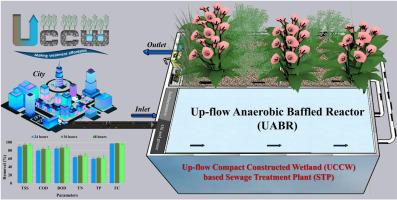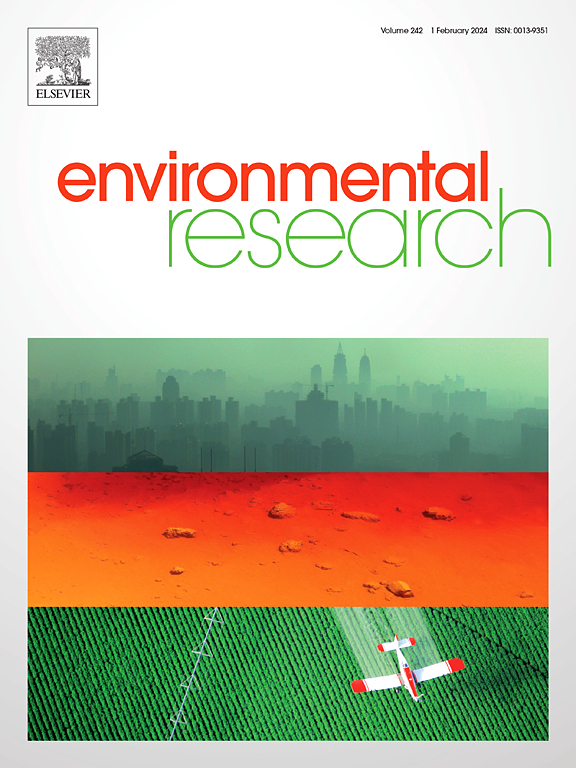An innovative design and development of up-flow compact constructed wetland for sewage treatment
IF 7.7
2区 环境科学与生态学
Q1 ENVIRONMENTAL SCIENCES
引用次数: 0
Abstract
The growing demand for sustainable sewage treatment requires technologies that overcome the limitations of energy-intensive and chemical-dependent systems. This study presents an innovative solution addressing both environmental and operational challenges with the design and development of an Up-flow Compact Constructed Wetland (UCCW) based Sewage Treatment Plant (STP). This system integrates preliminary, primary, secondary, and tertiary treatment units into a single setup. The performance of UCCW based STP was evaluated over 720 days under different Hydraulic Retention Times (HRTs), considering seasonal variations in both rectangular and circular configurations. The system achieved significant pollutant removal as Total Suspended Solids (96%), Chemical Oxygen Demand (86%), Biochemical Oxygen Demand (90%), Total Nitrogen (70%), Total Phosphorus (65%), and Fecal Coliforms (99%) at a 36-h HRT. These parameters meet discharge standards, except FC, which requires disinfection for safe reuse and recycling. Further, Response Surface Methodology (RSM) and Monte Carle Simulation of UCCW based STP confirmed optimal and reliable performance at a 36-h HRT. Compared to conventional treatment technologies, the UCCW based STP demonstrated higher efficiency, a smaller footprint (1m2/KLD), better operational flexibility, cost-effectiveness, and minimal operation & maintenance to make it sustainable for decentralised treatment.

创新设计和开发用于污水处理的上流式紧凑型构筑湿地。
对可持续污水处理的需求日益增长,这就需要能克服能源密集型和依赖化学品的系统局限性的技术。本研究提出了一种创新解决方案,通过设计和开发基于上流式紧凑型构筑湿地(UCCW)的污水处理厂(STP)来应对环境和运营方面的挑战。该系统将初步处理、一级处理、二级处理和三级处理单元集成到一个装置中。考虑到矩形和圆形配置的季节性变化,在不同的水力滞留时间(HRT)下,对基于 UCCW 的污水处理厂的性能进行了 720 天的评估。在水力停留时间为 36 小时的情况下,该系统对总悬浮固体(96%)、化学需氧量(86%)、生化需氧量(90%)、总氮(70%)、总磷(65%)和粪大肠菌群(99%)等污染物的去除率非常高。这些参数均符合排放标准,但 FC 除外,因为 FC 需要消毒才能安全回用和循环使用。此外,基于 UCCW 的 STP 的响应面方法(RSM)和 Monte Carle 仿真证实,在 36 小时 HRT 条件下,UCCW 具有最佳和可靠的性能。与传统处理技术相比,基于 UCCW 的污水处理厂效率更高、占地面积更小(1 平方米/KLD)、操作灵活性更好、成本效益更高、运行和维护费用更低,因此可持续用于分散处理。
本文章由计算机程序翻译,如有差异,请以英文原文为准。
求助全文
约1分钟内获得全文
求助全文
来源期刊

Environmental Research
环境科学-公共卫生、环境卫生与职业卫生
CiteScore
12.60
自引率
8.40%
发文量
2480
审稿时长
4.7 months
期刊介绍:
The Environmental Research journal presents a broad range of interdisciplinary research, focused on addressing worldwide environmental concerns and featuring innovative findings. Our publication strives to explore relevant anthropogenic issues across various environmental sectors, showcasing practical applications in real-life settings.
 求助内容:
求助内容: 应助结果提醒方式:
应助结果提醒方式:


